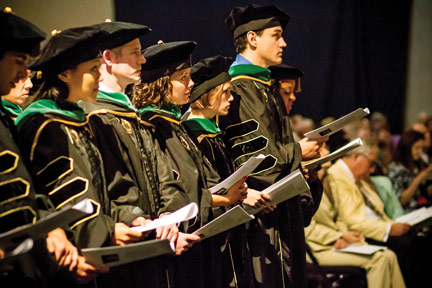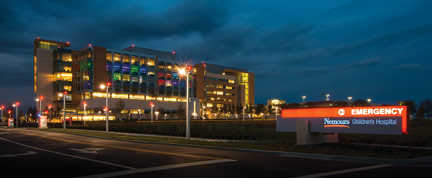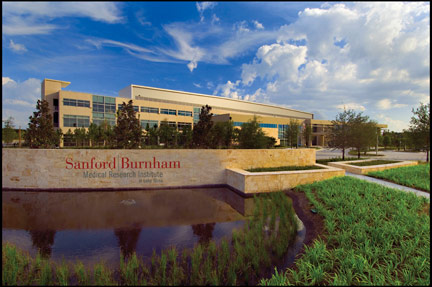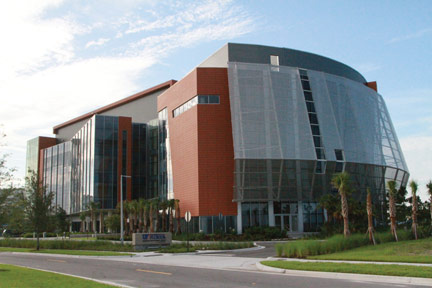
HEALTHY OUTLOOK
 Just off S.R. 417, five minutes east of Orlando International Airport, a 65-acre parcel of land has morphed into a $2 billion health-sciences campus encompassing a medical school, research laboratories and hospitals as well as new homes and businesses to support newcomers flocking to this burgeoning area.
Just off S.R. 417, five minutes east of Orlando International Airport, a 65-acre parcel of land has morphed into a $2 billion health-sciences campus encompassing a medical school, research laboratories and hospitals as well as new homes and businesses to support newcomers flocking to this burgeoning area.
Four years ago, Lake Nona’s Medical City, as it is colloquially known, was nothing but vast expanses of pastures and woods adjacent to a luxurious golf-course community favored by sports celebrities and corporate executives.
Its rapid transformation into one of the nation’s leading bioscience clusters is the result of hundreds of millions of dollars in government, nonprofit and private investment.
The project has powered forward pretty much according to plan, despite a national economic collapse that stopped growth in its tracks elsewhere. Now, the University of Florida Research and Academic Center, the Nemours Children’s Hospital, Sanford-Burnham Medical Research Institute, the University of Central Florida College of Medicine and the Burnett Biomedical Sciences Building, are all part of the Lake Nona landscape.
And there’s more to come. After several delays, the Orlando Veteran’s Affairs Medical Center is now projected for completion by June 2014. UCF may expand its presence by relocating its College of Nursing and possibly starting a College of Dental Medicine. There’s even been talk of a UCF-affiliated teaching hospital on university-owned land alongside to the medical school.
We're working at warp speed,” says Dr. Deborah C. German, vice president for medical affairs and dean of the UCF College of Medicine. “Six and a half years ago, the architects weren’t yet chosen. Now the medical education program is fully operational and we’ve graduated our first class.”
That graduation ceremony took place amid much pomp and circumstance on May 17. The charter class of 36 also was the first class of medical students in the nation to receive full-ride, four-year scholarships, worth $160,000 each, courtesy of community donors.
The unique scholarship program helped attract more than 4,300 applicants for 41 spaces, making the UCF College of Medicine the most selective medical school in the U.S. “You took a big chance,” said UCF President John Hitt during the commencement address. “You agreed to come to an unaccredited medical school. Your gamble paid off. Today, you are graduating debt free from a fully accredited medical school and are going to some of the best residencies in the nation.”
Added Hitt: “In decades to come, the UCF College of Medicine — a school you chartered — will grow in distinction.”
As will Medical City. In fact, boosters say the long-term impact of its various components will surpass that of Martin Marietta in the 1950s and Walt Disney World in the 1960s and 1970s. Orlando, they say, will become as well-known for leading-edge medical treatment and research as it is for world-class attractions and resorts.
Today, Medical City is home to the San-ford-Burnham Medical Research Institute’s $85 million, 178,000-square-foot facility, which opened in 2009 as the first piece of the Medical City puzzle. It includes the Diabetes and Obesity Research Center and the Conrad Prebys Center for Chemical Genomics. Scientists are also investigating potential treatments for cancer, Alzheimer’s and other diseases.

The institute’s LaJolla, Calif. facility recently made international news with an extraordinary potential breakthrough. Researchers discovered a combination of two FDA-approved drugs that seems to stop — and possibly reverse — changes in the brain caused by Alzheimer’s disease.
By combining two widely used drugs, nitroglycerin and memantine, researchers created a new drug they dubbed NitroMemantine. In animal models, the hybrid appears to restore synapses — the connections between neurons — lost as the disease progresses, according to findings published this week in the Proceedings of the National Academy of Sciences.
The combo drug is part of an overall effort based at the institute’s Lake Nona facility that explores ways scientists can “re-purpose” already approved drugs in new ways. “The potential of drug re-purposing is enormous and will accelerate the pace of drug discovery,” says Dr. Steve Gardell, the Lake Nona-based senior director of scientific resources.
UCF’s medical school, which also opened in 2009, is thriving as well. The Health Sciences Campus at Lake Nona now includes a 170,000-square-foot medical education facility, featuring the latest in lab and classroom technology, as well as the 198,000-square-foot Burnett Biomedical Sciences building.
This year, the M.D. program enrolled its fourth class of 100 students, bringing total enrollment to 280, a seven-fold increase in four years. Soon, the college will be at full enrollment, educating 480 physicians-in-training each year. The Burnett School is training more than 2,350 undergraduate majors in the biomedical sciences, including biotechnology, medical laboratory sciences and molecular biology.
German says the university plans to add new research buildings and to relocate the College of Nursing to the Lake Nona campus. And, despite a setback, she remains committed to starting a College of Dental Medicine.
That project hit a snag last year when UCF and Florida A&M University both expressed an interest in starting dentistry colleges at the same time UF was pushing to expand its nationally ranked dentistry program in Gainesville. When the Florida Board of Governors and the Florida Dental Association expressed opposition, UCF withdrew the plan in hopes of modifying and resubmitting it in the future.
“Our donors are still with us,” says German. “The long range plan has been substantially changed, but [the dental school] remains part of our vision.”
Speaking of UF, the state’s flagship university has added its formidable resources to the Lake Nona mix. In 2010 it broke ground on a $53 million, nearly 115,000-square-foot Research and Academic Center that houses its Institute on Aging — a program that studies, among other things, drug interactions in the elderly — as well as the UF College of Pharmacy, which has relocated its 200 students from Apopka to Lake Nona.
Dr. Lawrence J. Lesko, clinical professor and director of UF’s Center of Pharmacometrics and Systems Pharmacology, says the Lake Nona researchers will focus on supporting clinical research related to diabetes and cardiovascular disease as well as obesity. It will also help pharmaceutical companies develop treatments for Alzheimer’s disease.
Lesko’s team also works with medical partners to study the mechanisms of drug interactions and side effects in patients. The results will lead to better care for patients and closer cooperation between doctors and researchers.
And that’s not all. Through the UF Institute of Therapeutic Innovation, also located in Lake Nona, Dr. George Drusano and a team of infectious disease experts will conduct trials to help develop new anti-infectious disease drugs. These drugs will benefit organ transplant programs, and help hospitals prevent and treat infections.
The program currently enrolls 70 students each year, allowing 200-250 students an unprecedented opportunity to develop one-on-one relationships with medical researchers and scientists.

“The students have the ability to learn and work in an environment that’s more professional and unlike any other campus,” says Dr. Erin St. Onge, assistant dean and campus director/clinical associate professor. St. Onge is developing collaborative projects with the VA hospital and the medical school.
Another major Medical City anchor will be the Orlando Veteran’s Affairs Medical Center, slated to open next June. The $665 million, 1.2-million-square-foot facility will encompass 134 beds, including 22 intensive-care beds and 40 mental-health beds. A 60-bed domiciliary will provide assisted living and other services to economically disadvantaged veterans.
In addition there’ll be a medical simulation center and a research unit focusing on diabetes, obesity and other important areas of wellness.
“The Orlando campus at Lake Nona’s Medical City is a new build, a new clinical inventory, a new scope and a new culture,” says Timothy Liezert, the facility’s director. “We’re not just building a building — we’re fundamentally changing the way we provide care to the veterans of east central Florida.”
The campus will also include an outdoor courtyard and garden area and a veterans’ memorial, the only one of its kind in the country. The 3,500-plus medical professionals on staff will care for an estimated for 110,000 patients a year by 2015, according to Liezert.
“The new facility will provide in-patient bed space with very specific care for veterans and their families,” says Jeff Birdsong, executive in charge of activations. “We’ll also develop transportation alternatives to get veterans the care they need from other Central Florida outpatient sites.”
Finally, Nemours, a world-class pediatric healthcare provider with a hospital in Wilmington, Del., and clinics throughout Florida (including Orlando), New Jersey and Pennsylvania, picked Lake Nona for a 95-bed, 630,000-square-foot hospital. Nemours Children’s Hospital, which opened last October.
The private Nemours Foundation funded the project’s entire $397 million cost. “No tax money and no philanthropic dollars paid for the brick and mortar,” says Josh Wilson, senior manager, public and community relations for Nemours Florida.
Even though Orlando has two top-ranked children’s hospitals, Nemours is designed to focus on unmet needs in the community, says Dr. Ken Liechty, chair of surgery and surgeon-in-chief, who was recruited to the area from one of the top children’s hospitals in Mississippi.
“There’s a need in children’s care for an academic home to bring in people doing more than just practicing medicine,” says Liechty. “We’ll be bringing in people doing research and education.”
The Lake Nona facility, which is expected to employ about 800, includes healing gardens and pet therapy areas for patients. Adjacent to the eco-friendly facility, which is expected to receive LEED certification soon, is land for a future Ronald McDonald House.
Designed as a “healing environment,” Nemours offers elements that cure and comfort, from an emergency department and an ambulatory diagnostic center to patient rooms with garden views and a 16-foot, 1,500-gallon saltwater aquarium in the radiology waiting area.
Because parents of children who have endured hospital stays made design suggestions, furniture is more comfortable and rooms have day beds, a workspace for parents and more closet space.
Nemours also boasts a state-of-the-art emergency department with an innovative approach to emergency care. “We looked at what people had identified as best practices and best processes,” says Dr. Todd Glass, the hospital’s chief of emergency medicine. “We also brought in a group of people at the planning stage — parents, physicians, nurses and paramedics—for input on how to deliver care safely, efficiently and effectively.”
Innovations include placing a nurse in the reception area to immediately classify each patient’s emergency level. “By seeing the least complex patients quickly, we free up the rooms rapidly,” says Glass.
The ER has also adopted an integrated team approach to treatment: “The nurse and the doctor and the paramedics all see the patient at the same time, which is very unusual,” says Glass. “We come to consensus and lead from that perspective. That’s one of the big keys to our efficiency.” Students from Valencia College, which opened its seventh campus in Central Florida last fall at Medical City, will also benefit from Nemours’ proximity. The first of its four buildings encompasses 18 “smart” classrooms and six science labs, including a biotech lab, as well as a bookstore and a tutoring center.
Students from Valencia College, which opened its seventh campus in Central Florida last fall at Medical City, will also benefit from Nemours’ proximity. The first of its four buildings encompasses 18 “smart” classrooms and six science labs, including a biotech lab, as well as a bookstore and a tutoring center.
At buildout, the campus will boast more than 250,000 square feet of space and will accommodate as many as 10,000 students. For the spring 2013 term, approximately 1,900 students attended classes in Lake Nona, where the focus is on mathematics and high-level sciences.
Students are able to earn two-year associate of arts degrees in a variety of pre-professional programs. They may then transfer and complete their degrees at a four-year university. “We currently have interns placed at Sanford-Burnham and students actively volunteering at Nemours,” says Michael Bosley, executive dean of the Lake Nona campus.
Bosley adds that Valencia’s Osceola campus will collaborate with its Lake Nona campus to offer a new associate of science degree in biotechnology. Other programs in the proposed Life Sciences Institute will include physical and occupational therapy.
Clearly, Medical City has been an extra-ordinary success story. But it hasn’t been cheap. Various incentives used to spur the project have exceeded $ 1 billion. But so far, it appears to have been money well spent.
An economic impact study by Arduin, Laffer & Moore Econometrics in 2008 found the UCF College of Medicine, combined with a life-sciences cluster, could create 30,000 jobs with $2.8 billion in annual wages, generate $460 million in annual tax revenue and spur $7.6 billion in annual economic activity for the region by the end of 2017.
“Since 2005, there’s been $2 billion in active construction on site,” says Rob Adams, vice president of marketing for Lake Nona. “From the infrastructure we put in, to the hospitals, the research institute and medical school.”
But even more important than Medical City’s economic impact is this: The next major advances in the diagnosis and treatment of mankind’s most vexing diseases may very well originate in our own backyard. And that’s truly invaluable.
